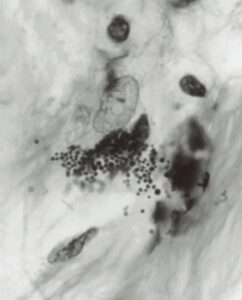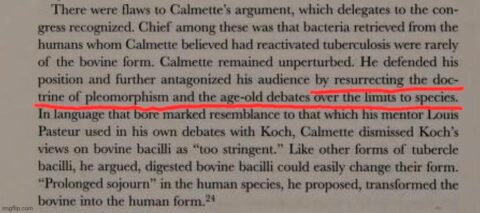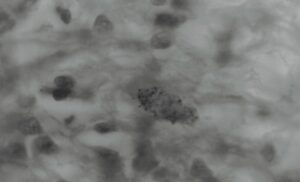Although Pasteur lacked Bechamp’s understanding of disease pathology, he established through his discoveries the essential political connections that extended as high up as the Emperor of France. The times favored Pasteur because his ideas were in tune with the science and the politics of his day; and Bechamp’s ideas were not.
Bechamp, despite his brilliance, was eventually eclipsed by the younger Pasteur. His research can be explored in the English edition of his book, The Blood and its Third Anatomic Element, published posthumously in 1912. The details of the scientific feud and plagiarism accusations can be found in Ethel Douglas Hume’s book, Bechamp or Pasteur?: A Lost Chapter in the History of Biology (1923). Remarkably, both books are still in print and available from Internet book sources.
Microzymas and bacterial pleomorphism
Robert Koch, a legendary figure in microbiology for his discovery in the late nineteenth century of acid-fast bacteria as the cause of tuberculosis (TB), was rigid in his belief that a specific germ had only one form (monomorphism). And he opposed all research showing some germs had more than one form (pleomorphism) and complex “life cycles.” Thus, from the very beginning of bacteriology there was conflict between the monomorphists and the pleomorphists, with the former totally overruling the latter and dominating microbiology to this day.
In the attempt to “classify” laboratory-grown bacteria as the lowest forms of life known at that time, there was no consideration given to any possible “connection” between any of the various species of bacteria. The dogma was that a coccus remained a coccus; a rod remained a rod; and there was no interplay between them. There was also no “crossing over” from one species to another, and the research of the pleomorphists suggesting otherwise was ignored.
When viruses were discovered they were made separate from bacteria, although bacteria are also known to be susceptible to viral infection. Viruses were put in one box; bacteria in another. As a result, the spectacular number of “filterable” pleomorphic microbial forms that form a bridge between the “living” bacteria and the “dead” viruses are still largely unstudied and considered of no great importance in clinical medicine.
Thanks to Pasteur, common “skin” bacteria like cocci and bacilli are often viewed as suspicious laboratory “contaminants” or “secondary invaders” or “opportunistic infections” of no great importance as etiologic agents. As a result of all this dogma and rigidity, medical thought was completely turned off to the possibility that certain cancers and chronic diseases might be caused by common pleomorphic bacteria originating in our own body cells. Therefore Bechamp’s idea that bacteria could arise from damaged human cells was deemed preposterous.
The legacy of Bechamp
Bechamp described the earliest stages of cellular microzymas as “granules.” Using a light microscope at its highest power, at a magnification of 1000 times. I don’t think it’s yet possible to definitively point to a single “granule” and claim it is a microzyma. A study of human microscopic pathology reveals the presence of countless granules in blood and tissue. However, because suitably-stained bacteria are visible at this magnification they are able to be identified. The appearance of blood and tissue bacteria associated with cancer and certain chronic diseases has been described by various (and always controversial) researchers since the dawn of microbiology in the late 1890s, when doctors finally accepted germs as a cause of disease. Unfortunately, modern doctors still do not accept bacteria that have been studied and reported in cancerous tissue and claimed to be the cause of cancer. Some vehemently oppose such a belief.
There are numerous scientists who owe a debt to Bechamp and his contention that human disease has its roots within the cells of the body itself. Cells are damaged. The microzymas within the cell react to this damage. Microbes develop from microzymas within the damaged cells, resulting in cellular inflammation and disease production.
In 1890 William Russell, a renowned Scottish pathologist, described “the parasite of cancer” that he discovered in every cancer he examined. German zoologist Gunter Enderlein (1872-1968) studied aspects of the microbes emanating from microzymas, labelling them as “protits” and described a “life cycle” for these pleomorphic organisms. Canadian microbiologist Gaston Naessens (1924- ) has also studied the life cycles of blood microbes he defines as “somatids” and other forms. With his specially-designed microscope capable of time-lapse microphotography, Royal Raymond Rife (1888-1971) was the first to directly visualize viruses and transformations of pleomorphic bacteria in human tissue. His scientific achievements are recounted by Jeff Rense on Rense.com
Undoubtedly related to Bechamp is the cancer research of the notorious Wilhelm Reich (1897-1957), whose studies and conclusions concerning
“bions” and “T-bacilli” derived from cancerous cells eventually landed him in an American prison where he died. My mentor Virginia Livingston (1906-1990), along with her co-workers, spent a lifetime in research preaching that cancer was caused by pleomorphic acid-fast bacteria. For more on these two physicians, see ‘Virginia Livingston: Cancer quack or medical genius?’ and ‘Dr. Wilhelm Reich: Scientific genius—or medical madman?’ on Rense.com
Despite the general belief that normal, healthy human blood is “sterile,” there is more and more evidence that human blood harbors bacteria normally, both in health and disease. These bacteria have been determined to be staphylococcal, streptococcal, and corynebacteria-like pleomorphic cell wall deficient bacteria, some of which are acid-fast. For examples of direct viewing of microscopic findings of bacteria in normal blood, see Tom Detwiler’s website (www.bloodmicrobe.org).
Microzymas, tissue granules and coccoids, and cell wall deficient bacteria
How are microzymas related to the bacterial theory of cancer? According to Livingston and others, the cancer germ is an intra- and extracellular bacterium that can be identified by special staining of cancerous tissue, particularly the acid-fast stain—a stain traditionally used to detect TB bacteria. Cancer bacteria are pleomorphic, some of the largest “large body forms even attaining the size of red blood cells.
The most common form in tissue is the granular (coccoid) form. However, pathologists do not accept the idea that these tissue bodies are microbial in nature. The larger bodies are sometimes interpreted as “Russell bodies” of dubious origin, but never as Russell’s “parasite of cancer.” (For more on large bodies, see my online article: ‘The return of the cancer parasite.’)
Figure 1. Fite (acid-fast) stained tissue section of AIDS-related Kaposi’s sarcoma of the skin. Arrows point to a collection of variably-sized coccoid forms and granules (microzymas?) in the dermis portion of the skin. Insert shows Gram-stained Staphylococcus epidermis cultured from the tumor. Note the size and shape of the staphylococci in lab culture which appear similar to those coccoid forms seen in the tumor. Magnification x1000, in oil.

Figure 2. Tissue section of breast cancer showing a group of variably-stained extracellular coccoid forms. Compare the size of these “granules” with the size of a group of red blood cells seen in the upper right. Fite stain, x1000, in oil.

Figure 3. Tissue section of prostate cancer showing a cell laden with intracellular coccoid forms. A few of the forms emanate from the cell and become extracellular. Fite stain, x1000, in oil.

Figure 4. Tissue section of Hodgkin’s disease (lymphoma) of the lung showing a cell with intracellular granules and coccoid forms (microzymas?). Gram stain, x1000, in oil.
[Ed. note: In the original article the file names of figures 4 and 5 or their descriptions are interchanged.]
Figure 5. Autopsy section of connective tissue from a fatal case of Hodgkin’s disease. The coccoid forms breaking out of the cell are
variably-sized (pleomorphic) and some of the largest round forms attain the size of “large bodies.” Fite stain, x1000, in oil.
If bacteria evolve from the microzymas within the cell, as Bechamp proposed, the first appearance would be the formation of granules and coccoid forms intracellularly. The following five microphotographs show examples of how these granules (microbial coccoid forms) might appear in cancerous tissue, such as in AIDS-related Kaposi’s sarcoma of the skin, breast cancer, prostate cancer, and Hodgkin’s disease (lymphoma).
Bechamp and the future of medical science
At the turn of the 21st century a remarkable acknowledgment took place. Scientists now believe that that the majority of our body cells are not human cells. On the contrary, 50% of our cells or more are estimated to be microbial cells, mostly bacteria. There are over 37 trillion cells in our bodies.
What role do our trillions of body microbes play in the chronic diseases of aging and in cancer? At present, we don’t know. We now recognize these germs are scattered in various tissues and organs of the body once thought to be sterile. And the blood contains bacteria which undoubtedly are carried to every cell in the body.
So why do doctors object so strongly when a scientist concludes that bacteria (rather than viruses) play a role in cancer? Are doctors failing to recognize bacteria in cancerous tissue? Whatever the answer, the role of bacteria in cancer will have to be settled once and for all. In the meantime we continue to ignore cancer microbe research to the detriment of the patient.
Pasteur was the genius of his day; and Bechamp’s microzymian theory and contrary views were an annoyance to the Academy. The medical establishment knew how to deal with rebels like Bechamp. His work would be ignored by the “authorities” and never cited by the “experts.” His ideas would never be taken seriously in journals and textbooks. Biomedical editors would purge his name from the pages of their scientific publications. Bechamp would quickly vanish from the annals of science. This is the way all medical rebels are silenced by the establishment.
Suggested reading: (These articles can be found on www. Rense.com by using the website’s search engine)
Broxmeyer L and Cantwell A: AIDS: “It’s The bacteria, stupid!” (2008)
Cantwell A: Cancer is an infection caused by tuberculosis-type bacteria. (2008)
Cantwell A: All human blood is infected with bacteria. (2007)
Cantwell A: Do TB-type bacteria cause AIDS? (2007)
Cantwell A: Immortal HeLa cells and the continuing contamination of cancer and vaccine research. (2010)
Cantwell A: The ‘Star Cell’; The microscopic indicator of bacterial infection in cancer, AIDS and chronic disease . (2011)
[Alan Cantwell, M.D. is a retired dermatologist and cancer researcher. He is the author of The Cancer Microbe and Four Women Against Cancer, both available from Amazon.com]
Es gibt nahezu auf jedes bereits erkanntes und erforschtes Bakterien, Virus und Pilz ein Testverfahren, um nachzuweisen, ob der Betroffene diese in seinem Körper hat. Diese Testverfahren werden genutzt, um entsprechende Handlungsweisen (Therapien, Medikamente) aus dem Ergebnis ableiten zu können. Denn die Annahme besteht darin, dass sowohl Bakterien, Viren, als auch Pilze eine krankmachende Funktion besitzen und dadurch der Mensch krank werden kann. Diese Annahme und damit die Deutung die aus den Testungen entsteht, ist jedoch falsch. Genau das werde ich dir in diesem Video ausführlich erklären.
Die Rockefeller-Keimtheorie ein für alle Mal ablehnen
von Jon Rappoport , 27. Juli 2022
Übersetzung: Dr. Barbara Kahler
Hinweis: In einer Reihe von Artikeln habe ich überzeugende Beweise dafür vorgelegt, dass die Todesfälle, die COVID-19 zugeschrieben werden, ohne Bezug zu einem Virus erklärt werden können. Außerdem sehe ich keine überzeugenden Beweise dafür, dass “alternative Behandlungen”, welche Vorzüge sie auch immer haben mögen, irgendetwas mit der “Neutralisierung eines Virus” zu tun haben.
Der gesamte tragische, kriminelle, mörderische, dumme, absurde COVID-Betrug basiert auf hundert Jahren Rockefeller-Medizin – einer pharmazeutischen Tyrannei, deren beständige Schlagzeile lautet:
EINE KRANKHEIT, EIN BAZILLUS.
Das ist das Motto, das auf dem Tor des medizinischen Kartells eingraviert ist.
-Tausende von so genannten separaten Krankheiten, jede verursacht durch einen einzelnen Keim.
“Töte jeden Keim mit einem giftigen Medikament, verhindere jeden Keim mit einem giftigen Impfstoff.”
Ohne diese hundert Jahre falscher Wissenschaft und Propaganda wäre die Werbung für COVID-19 wie ein schlechter Scherz aufgegangen. Ein paar säuerliche Lacher und dann nichts mehr, außer dass die Menschen mit ihrem Leben weitermachen.
Die allgemeine Gesundheit eines einzelnen Menschen hat mit Faktoren zu tun, die nichts mit “einer Krankheit, einem Keim” zu tun haben.
Wie ich zum Beispiel am Ende eines kürzlich erschienenen Artikels zitiert habe –
“Die kombinierte Sterblichkeitsrate durch Scharlach, Diphtherie, Keuchhusten und Masern bei Kindern bis zu fünfzehn Jahren zeigt, dass fast 90 Prozent des gesamten Rückgangs der Sterblichkeit zwischen 1860 und 1965 vor der Einführung von Antibiotika und weit verbreiteten Impfungen stattgefunden hat. Zum Teil kann dieser Rückgang auf verbesserte Wohnverhältnisse und eine geringere Virulenz der Mikroorganismen zurückgeführt werden, aber der bei weitem wichtigste Faktor war eine höhere Wirtsresistenz aufgrund besserer Ernährung.” Ivan Illich, Medical Nemesis, Bantam Books, 1977
Und Robert F. Kennedy, Jr.: “Nach eingehender Untersuchung eines Jahrhunderts aufgezeichneter Daten kamen die Centers for Disease Control and Prevention und Johns Hopkins Forscher zu dem Schluss: ‘Impfungen sind also nicht der Grund für den beeindruckenden Rückgang der Sterblichkeit durch Infektionskrankheiten in der ersten Hälfte des zwanzigsten Jahrhunderts’.”
“In ähnlicher Weise veröffentlichten 1977 die Epidemiologen (und Eheleute) John und Sonja McKinlay von der Boston University in der Zeitschrift Millbank Memorial Fund Quarterly ihre bahnbrechende Arbeit über die Rolle, die Impfstoffe (und andere medizinische Eingriffe) bei dem massiven Rückgang der Sterblichkeit im zwanzigsten Jahrhundert um 74 % gespielt haben: ‘The Questionable Contribution of Medical Measures to the Decline of Mortality in the United States in the Twentieth Century’.”
“In diesem Artikel, der früher Pflichtlektüre an den medizinischen Fakultäten der USA war, wiesen die McKinlays darauf hin, dass 92,3 % des Rückgangs der Sterblichkeitsrate zwischen 1900 und 1950 stattfand, also bevor es die meisten Impfstoffe gab, und dass alle medizinischen Maßnahmen, einschließlich Antibiotika und Operationen, ‘anscheinend wenig zum Gesamtrückgang der Sterblichkeit in den Vereinigten Staaten seit etwa 1900 beigetragen haben – sie wurden in vielen Fällen erst mehrere Jahrzehnte nach einem deutlichen Rückgang eingeführt und hatten in den meisten Fällen keinen nachweisbaren Einfluss’.”
Wie das Immunsystem (wenn es denn ein System ist) tatsächlich funktioniert, geht über die derzeitigen medizinischen Hypothesen hinaus.
“T-Zellen, B-Zellen, neutrophile Granulozyten, Monozyten, natürliche Killerzellen, Proteine” werden zu einer atemlosen Geschichte über eine militärische Maschine zusammengeschweißt, die Eindringlinge angreift. Push-Pull. Suchen und zerstören.
Die Vorstellung, dass DAS die Gesundheit ausmacht, ist töricht.
Positive Vitalität ist das, was uns gesund hält.
Einige Faktoren positiver Vitalität stehen auf der tyrannischen COVID-Liste dessen, was vernichtet werden sollte: finanzielles Überleben; offenes Zusammensein mit Freunden und Familie; Menschen, die sich (unmaskiert) ansehen; offene Kommunikation ohne Angst vor Zensur.
Ernährung und sanitäre Grundversorgung sind natürlich wichtige Vitalitätsfaktoren.
Und dann geht es um den Sinn des Lebens: Woher nehmen die Menschen ihre kreativen Energien?
Es liegt auf der Hand, dass die Freiheit von schädlichen medizinischen Behandlungen eine Voraussetzung für die Entfaltung der Vitalität ist.
Die Unterdrückung des LEBENS, um einen vermeintlichen Keim zu stoppen, ist institutionalisierter Tod.
Die moderne Medizin wird in einem Bericht, den ich in den letzten 10 Jahren dutzende Male erwähnt habe, auf sensationelle Weise entlarvt: Er wurde von der verstorbenen berühmten Ärztin für öffentliche Gesundheit am Johns Hopkins, Barbara Starfield, verfasst und trägt den Titel “Is US Health Really the Best in the World?” Sie wurde am 26. Juli 2000 im Journal of the American Medical Association veröffentlicht.
Darin wird festgestellt, dass das medizinische System in den USA jedes Jahr 225.000 Menschen tötet.
Pro Jahrzehnt würde sich die Zahl der Todesopfer auf 2,25 Millionen Menschen belaufen.
Das werden Sie in den CDC-Berichten nicht finden.
2009 habe ich Dr. Starfield interviewt. Ich fragte sie, ob die Bundesregierung eine größere Anstrengung unternommen habe, um den medizinisch bedingten Tod in Amerika zu beheben, und ob sie gebeten worden sei, die Regierung bei einer solchen Anstrengung zu beraten.
Beide Fragen beantwortete sie mit Nein.
– Original: Rejecting Rockefeller Germ Theory once and for all
Weiterführend: Einmalige Wissenssammlung von Jon Rappoport über die Pharmaverschwörung
09.08.1930/31.05.2024, Brisbane Courier: Arthur Thomson: Confirmed Claims

Ganzer Artikel als pdf.
Komm. von ViroLIEgy: “A 1930 article by Scottish naturalist Arthur Thomson stated that Antoine Bechamp’s claims about pleomorphism, which were denied by Louis Pasteur, were confirmed by a researcher from Pasteur’s own institute as well as by Bechamp’s student Victor Galippe.”
01.06.2024, ViroLIEgy: Pasteur Institute supports Bechamp’s pleomorphism
Albert Calmette, the medical director of the Pasteur Institute in Lille, a protege of Pasteur & Metchnikoff, & an internationally recognized researcher, was the person linked to Pasteur who supported Bechamp’s pleomorphism.
1. Pleomorphism (microbiology)




